st. peter’s basilica ( Papal Basilica of Saint Peter in the Vatican )
Located in the Vatican City, Saint Peter’s Basilica (st. peter’s basilica ) is one of the Catholic Church’s holiest sites and foremost pilgrimage sites. It was built over the burial site of Saint Peter, Christ’s leading apostle and the first pope. The current pope presides over religious rituals and celebrations here.
With an internal length of 186.36 meters and an internal width of 91 meters, the Basilica is regarded as the largest church in the world, with 15,160 square meters of interior space.
In 1506 the old basilica was torn down and the new one was built. It was completed in 1614, but not consecrated until 18 November 1626. The church was designed by a number of top architects, including Michelangelo.
history of st peter’s basilica

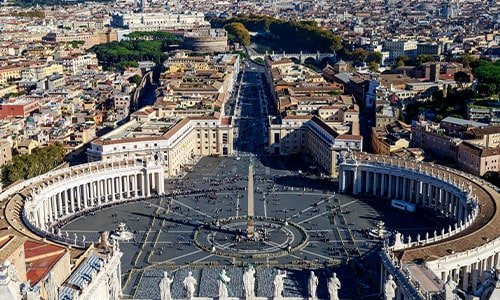
Historically, Saint Peter was crucified upside-down either on Janiculum Hill (about a kilometer south-east of the present basilica) or on the Ager Vaticanus, the area owned by the mad emperor Caligula, a racetrack for chariot races.
facts about st peter’s basilica
In the Roman era, St. Peter was buried next to the Via Cornelia, the Roma road that ran along the side of the circus. Since he is considered to be the first Pope, the small shrine where he rests was chosen as the location of the Catholic Church’s most important sanctuary and spiritual center.
Constantine, Emperor of Rome in 319 AD, decided to build a large Basilica dedicated to St. Peter on the slopes of the Vatican Hill, north of the Transtiberim district (now known as Trastevere). Despite construction continuing until around 340 AD, it was consecrated in 326 AD.
The basilica is built over St. Peter’s grave, which was believed to have been buried there. During a Saracen raid in 846 AD, this holy site was damaged and desecrated, but the massive building with its 120 altars stood until Pope Julius II (1503-1513).
The vision and ambition of Pope Julius II led to the building of the world’s most impressive church, which was built gradually over the next 120 years, with several design changes. The building was designed by Raphael, Baldassare Peruzzi, Antonio da Sangallo the Younger, Michelangelo, Carlo Maderno, and Gian Lorenzo Bernini, among many others.
Due to Pope Julius‘ decision to raise the vast sums of money required to build his new church by selling indulgences, a practice Martin Luther despised, the new basilica also led to the Reformation in western Christianity.
It was designed to rival the dome built by Brunelleschi in Florence a century earlier. The construction of the pilasters to support the dome was barely underway when Pope Julius died in 1513.
The dome‘s imposing base or “drum” had been raised by Michelangelo‘s death in 1564. It was finally completed in 1590 by Giacomo della Porta, who had been appointed by Sixtus V in 1585 to construct the dome. The dome is divided into sixteen sections by raised ribs.
Adding about seven meters to Michelangelo‘s plans, he raised the dome’s height to even more effectively dominate the Roman skyline. After Domenico Fontana completed the lantern atop the dome, the dome was complete.
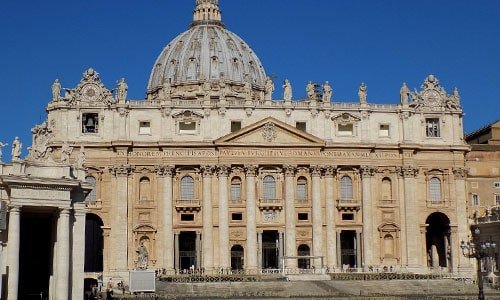
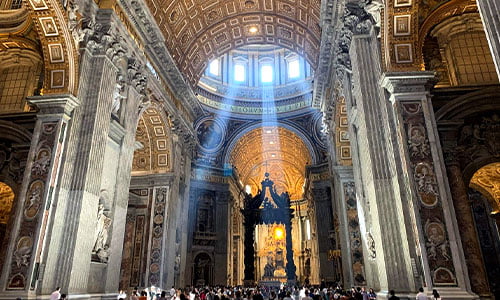
Millions of pilgrims and tourists visit St. Peter’s Basilica every year (an estimated 5.9 million people visited the Vatican in 2014), making it the center of Catholicism.It can accommodate over 20,000 people and is truly a gigantic building. The dome measures 58.9 meters in diameter (internal diameter = 41.5 meters), reaching a height of 136.5 meters to the top of the cross upon the lantern. The exterior length is 211.50 meters (including the portico or narthex).
The Basilica now has over 10,000 square meters of mosaics, including those inside the dome. Their appearance is almost identical to that of real paintings when viewed from a distance.
You can buy st peter’s basilica Vatican tickets from here
You can book st peter’s basilica and Sistine chapel tour from here
What’s Inside St. Peter’s Basilica?
A series of priceless treasures in marble and bronze can be found within the basilica, as well as papal tombs and some famous paintings.
Michelangelo’s Pieta
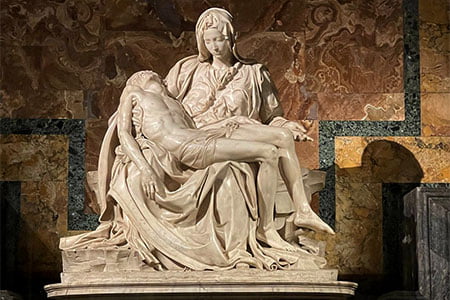
A masterpiece of Michelangelo, the Pieta is one of the most recognized statues in the world. Mother Mary holds Jesus after his crucifixion in the lap of the Carrara marble structure.
A monumental sculpture that towers almost six feet high, the sculpture represents the sanctity of the moment. The Pieta sculpture, which roughly translates to Pity, was created by Michelangelo in the late 15th century. When you enter St. Peter’s Basilica, this breathtaking statue is located in the first chapel to the right.
Cupola – ( the Dome )
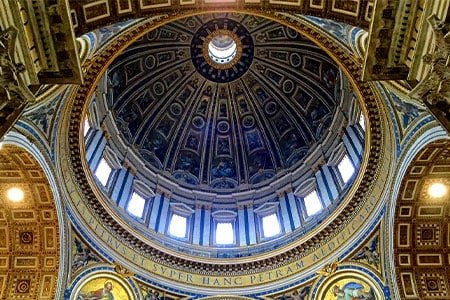
The dome of St. Peter’s Basilica, or the Cupola, is one of the largest domes in the world. This dome was designed by Michelangelo. His pupil Giacomo Della Porta, however, completed the dome construction only in 1590. In addition to 16 large windows, busts, frescoes, and figurines of more than 96 figures, the cupola is adorned with several elements across six concentric circles. A total of 231 steps can be climbed or an elevator can be used to reach the cupola base, and another 320 steps will take you up to the cupola’s top.
The Papal Altar
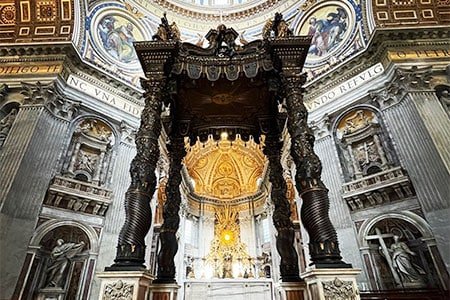
The Papal Altar, designed by Gian Lorenzo Bernini, is located at the center of Saint Peter’s Basilica. Finished over an 11-year period, the altar has a bronze four-pillared canopy in a baroque style. The altar was built over the tomb of St. Peter, making it the most important part of the church. The Papal Altar includes two main features: the Baldacchino and the Chair of St. Peter. Here is where the Pope performs Mass.
Statue of St. Longinus
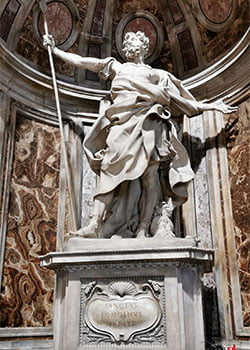
In St. Peter’s Basilica, the Statue of St. Longinus can be found in a gallery called ‘loggia’. This Bernini statue stands over 13 feet high and must be seen from a certain angle. An evocative marble sculpture shows St. Longinus, the Roman centurion who pierced Jesus with a lance but converted to Christianity after Christ‘s death. Approximately four blocks of marble were used in the construction of the statue in 1643.
St. Peter’s Tomb
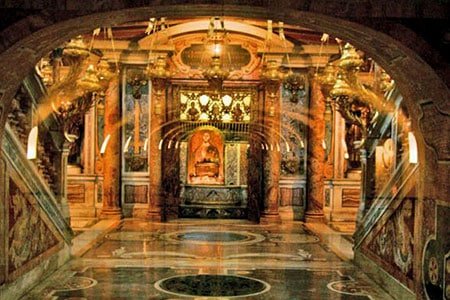
It is believed that St. Peter was crucified in Caligula’s Circus back in 64 C.E. Afterwards, he was buried on Vatican Hill. During Constantinople’s reign, a church was built on the tomb of St. Peter, which was later converted into the current St. Peter’s Basilica in the 16th century. Currently, a Confessio area is created in front of St. Peter’s Tomb to commemorate his martyrdom. The papal altar above the tomb and several popes buried below the tomb make up the Vatican Necropolis.
Bronze Statue of St. Peter
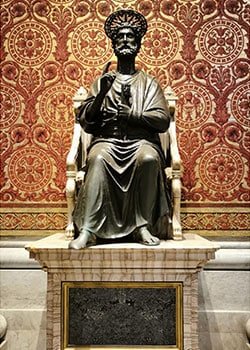
An important part of the Basilica is the famous statue of St. Peter, which dates back to the 5th century and stands against the pillar of St. Longinus. The saint sits on a marble chair, holds the keys of heaven in his left hand, and raises his right hand in blessing. Toes have worn thin over the years due to pilgrims touching and kissing the foot.
QUESTIONS AND ANSWERS
What is the St. Peter’s Basilica?
A Renaissance-style church in Vatican City, St. Peter’s Basilica. Designed by Donato Bramante, Gian Lorenzo Bernini, Michelangelo, and Carlo Maderno between 1506 and 1626, St. Peter’s Basilica is the world’s biggest church.
What is the location of St. Peter’s Basilica?
The Basilica of St. Peter is located at Piazza San Pietro, 00120 Città del Vaticano, Vatican City.
What can I see inside the St. Peter’s Basilica?
In St. Peter’s Basilica, there are a number of main attractions, including the Dome of the Basilica, the Vatican Grottoes, Michelangelo’s Pieta, and St. Peter’s Baldachin, St. Longinus’ statue, St. Peter’s Tomb, and the Chair of St. Peter.
Why is it called St. Peter’s Basilica?
In Catholic tradition, St. Peter’s Basilica is believed to be where Saint Peter, one of Jesus’ twelve apostles, was buried. It is also believed to be the burial place of the first Roman bishop, Saint Peter.
How long did it take to build St. Peter’s Basilica?
The construction of St. Peter’s took 150 years, and Michelangelo was only the architect for 18 of them. It is Michelangelo’s building, however
How long is the queue for St. Peter’s Basilica?
There is no admission fee to visit St Peter’s Basilica, but expect long queues of up to two hours. You can skip the line by purchasing special skip-the-line tickets with audio guides if you don’t want to stand in line for two hours. You can book these online at Tiqets or at GetYourGuide.
Is st peter’s basilica the largest church in the world ?
The Basilica of San Pietro or St. Peter’s Basilica, with its 23,000 m2, of which 15,160 are walkable, a height of 133.30 m and a length of 218 m, is the world’s largest Catholic church. It has been a spiritual destination for tourists and faithful from around the world since 1626.
st peter’s basilica and sistine chapel tour
Useful Information
There is no entrance fee to St. Peter’s Basilica. By booking a group tour or a private tour, you can avoid the long queue.
Opening days and times 2024
From October 1st to March 31st it is open every day from 7.00 am to 6.30 pm.
From April 1st to September 30th it is open every day from 7.00 am to 7.00 pm.
The entrance is allowed after 1.00 pm on Wednesdays, Sundays, and during festivities for religious reasons.
Closed on January 1st and 6th.
Visit the Vatican Necropolis
The excavating of the tomb of St Peter is only permitted occasionally when special permission is granted by the Excavations Office. Email [email protected] to see if you can get a reservation for your preferred date. A fee of 13 euros is charged per person.
How to get there
The Basilica of St Peter is located in Vatican City, across the Tiber River from Rome’s ancient center. Address: Piazza San Pietro, 00120 Vatican City, Vatican City.
Book online
Vatican Museums Tickets & Tours 2024
Best time to visit St Peter’s Basilica
The best time to avoid the rush is early in the morning. Early in the morning, St Peter’s will have fewer queues if any. Tours start arriving and so do the people, but many tours have fast-track tickets, so they will skip the queue.
If you do not want to get started early, you can buy a fast-track ticket online. By late afternoon, you will see a slow decline in visitors, and the closer you get to closing time at 7.00 pm in peak season or 6.00 pm in winter, the shorter the queue is likely to be.
What to wear at the Vatican
At St Peter’s Basilica, the dress code is strictly enforced.
It is mandatory for men to wear long trousers (no shorts) and cover their shoulders. It is not allowed for women to wear bare shoulders or skirts that are shorter than the knee.
